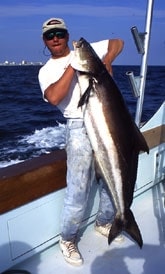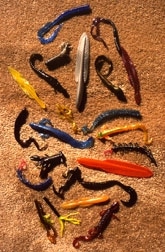
|| |—| || |Photo: Bob McNally| It still comes as a revelation to some salt water anglers that a wide variety of fish are pushovers for soft-plastic lures – the same plastic worms, lizards, eels and wiggly lures largemouth bass fishermen have been using in fresh water for decades. At times, it even shocks me.
Last April my son Matt and I were running across a huge shallow sand flat on Tampa Bay following a day of great snook fishing with Captain Joel Brandenburg of Apollo Beach. Brandenburg was running the boat from the tower and spotted a big cobia. Matt and I jumped into action.
With a live well full of herring baits, Brandenburg motored into position as Matt and I hurriedly rigged them up to fire at the cobia. We had plenty of shots, but the cobia refused every time. Finally, in desperation, I grabbed an eight-inch soft-plastic eel imitation and threaded it onto a live-bait hook fitted below a float. I passed it to Matt and on his second cast, the 50-pound cobia slammed it hard.
Why that cobia passed up live baits, yet instantly hammered a soft-plastic eel imitator I’ll never understand. But I’ve seen fish react similarly numerous times. As a result, I have learned that there are some refinements in selecting, presenting and rigging soft-plastics that help produce consistent catches.
CRAWLER CRAZY
For big fish like cobia and striped bass, I find that larger plastic worms work better. One of my favorites is an old two-hook-rigged Hawg Hunter plastic worm. It measures 13 inches overall and features a serrated back for excellent undulating action. It was made by the now-defunct J.W. Lure Company in Jacksonville, Florida. Thankfully, a few companies currently manufacture similar large plastic worms, all designed for oversize fresh water bass. Some of these worms come in smaller eight- to 12-inch lengths, such as the eight-inch KilR Eel by DeLong Lures in Indiana, and they are absolutely deadly in salt water. A few come already rigged with hooks connected with heavy-test braided line that is molded inside each plastic worm. Rigged worms are practical and effective for non-toothy species. But for fish with sharp teeth, they won’t last long.
Instead, long plastic worms measuring seven to 12 inches – such as those from Mister Twister, Lunker City and Mann’s Bait – can be fitted onto jigheads or rigged using a single large hook in the 3/0 to 5/0 range.
FISH FAKES
Oversize soft-plastics made to look like fish are a personal favorite. Mann’s popular Jellyhoo lure is a good example. Jellyhoos measure eight inches long and were designed for offshore trolling when natural ballyhoo are unavailable.
Rigging Jellyhoos and other similarly shaped, soft-plastic lures is a bit different than setting up plastic worms – especially if wire is needed for toothy fish. Nylon-coated braided wire in 20- to 30-pound test makes rigging easy. Simply tie a 12-inch length of wire to a worm-style hook – preferably a wide-gap model – with a clinch knot. Rig some with slip-sinkers and some without.
THE JERK

| |Photo: Bob McNally| Soft-plastic jerkbaits, such as the Slug-Go, are among the most innovative lures ever to hit the market.
Jerkbaits don’t look like much, but when rigged with a single hook and worked with a jerk-wind-jerk retrieve they come alive. The bait scoots and dives, falls and wiggles, and will trigger finicky fish into striking hard. They can be rigged snagless for casting around weedbeds, mangroves, jetties and shell bars. They can also be fished deep by using a sliding-sinker fishfinder rig.
While soft-plastic lures are far from the typical marine angler’s never-fail offering, they most assuredly have a distinguished place in every salt water fisherman’s tackle box and just might be the difference between a fishless outing and a trip to remember.
| HIGH PERFORMANCE HOOKS High Performance (HP) hooks from Eagle Claw are a truly revolutionary concept for catching big fish with light line.The hooks can be used with virtually any soft-plastic lures, including worms, eels, lizards and jerkbaits. HP hooks are shaped like an old-style Kahle hook, but with an innovative wire harness secured to the hook’s eye. The odd shape and slightly bent shank of the hook make it one of the easiest to set on the strike. The wide gap between its eye and point makes it highly effective when used with soft-plastic lures. To rig a soft-plastic lure, detach the wire arm of the harness and thread the soft-plastic onto the HP hook, burying the point in standard Texas-rig fashion. Once the lure is rigged on the hook, the arm clips onto the shank – snug against the head of the lure – preventing the soft-plastic from slipping down the shank. For information, call (303) 221-1481 or visit www.eagleclaw.com. |









